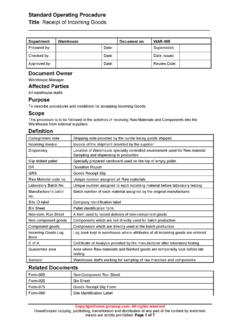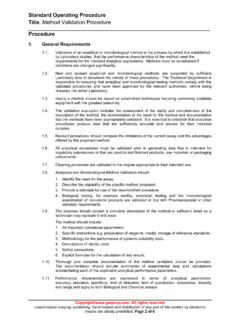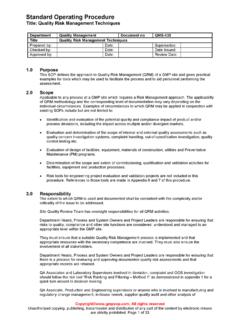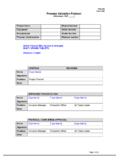Transcription of MAN-015 Factory Cleaning Procedure - GMPSOP
1 Standard Operating Procedure Title: Factory Cleaning Procedure Copyright All rights reserved Unauthorized copying, publishing, transmission and distribution of any part of the content by electronic means are strictly prohibited. Page 2 of 10 Handling chemicals, Formaldehyde - see SOP EHS-005 Using IPA/Solvent gloves must also be worn. Washing walls and ceilings Every Cleaner should be trained in Emergency Procedures (SOP EMR-005) Table of Contents 1. The General Rules and GMP 2 2. Areas of the Plant and Hygiene 2 3. Degree of 3 4. Cleaning 4 5. Supply and Store 5 6. Cleaning Methods.
2 5 7. Cleaning Procedures for Sterile 7 8. Tacky 9 9. Security of 9 10. Weekly Recording and Environmental 9 11. Summary of Procedure 1. The General Rules and GMP Requirements 1. The rules and GMP requirements apply equally to Contract Cleaners and Operations staff. 2. All cleaners should undergo Induction conducted Site and be supervised while working in the Plant. 3. Clean uniforms, Factory shoes and hats must be worn as applicable in the particular areas. (All cleaners working in the Production areas must be familiar with the requirements of SOP MAN-005) 4. Solutions, buckets, mops, etc., used for Cleaning must be changed/renewed daily or whenever they become badly soiled, so as not to spread the soil.
3 This is to be done by the Cleaners during the Cleaning process. 5. No food or drink can be taken into the Factory . 6. Rubbish should be collected in either bins or bags and disposed of cleanly in the correct bins. (Any filled product MUST go into the "FILLED PRODUCT" security disposal bin. Other security waste to be placed into the "NON-FILLED" security disposal bin. Any tablets picked up from the floor are to be collected and placed in a container on the area Manager s desk for reconciliation. If a tablet that is currently being packed is picked up from the floor, place the tablet in the rejects floor bin and contact the area Manager.)
4 7. Nothing should be picked up from the floor and returned to packing lines. 8. No container that comes in contact with product should be placed directly on the floor. 9. If Production is continuing in an area to be cleaned, advise the authorised person and work effectively in small areas, avoid creating large, wet, slippery areas. 10. Special Cleaning should be arranged with the Production Managers preferably when sections of the plant are closed down. 11. All problems should be reported to the Cleaning Supervisor who will liaise with Cleaning Coordinator or Quality Assurance Manager. 12. All Cleaning equipment and bulk solutions must be stored neatly in specific cleaners' rooms.
5 13. The Cleaners' rooms are to be kept in a neat, tidy, clean state. 2. Areas of the Plant and Hygiene Classes Standard Operating Procedure Title: Factory Cleaning Procedure Copyright All rights reserved Unauthorized copying, publishing, transmission and distribution of any part of the content by electronic means are strictly prohibited. Page 4 of 10 There are some sections of the Plant, which are cleaned on a periodic basis; on request; or after rebuilding or major maintenance, Duct-work; pipes/drains, lights; windows. This work will be requested by the Cleaning Coordinator or delegate when a need is perceived and a practical time agreed.
6 Note During special building or equipment installation activities, the Building Contractor or Project Manager will be responsible for protecting the plant, (floors, etc.) from the building debris. They will also ensure it is moved off-site. 4. Cleaning Aids Buckets There are three types of bucket systems used within Site. These are the single, double bucket system and the triple bucket system. Single Buckets These are roller wringer buckets. The buckets are colour coded to each environmental grade of the Factory and are dedicated to these areas. Green buckets for E areas, Blue for D and Yellow for C. Double and Triple bucket systems This is a trolley holding two large buckets.
7 Over one bucket is suspended a mop squeezer, and this is considered the "dirty" bucket. The other bucket, ("clean" bucket) accommodates the clean floor Cleaning /disinfecting solution. The buckets should be cleaned on a daily basis and the mop head and solution changed on a daily basis. The mop should remain in the clean bucket when not in use. These buckets are the only type that should be used within the sterile area and should be dedicated to that particular area of the cleanroom. Mops Cotton mops with a plastic or anodised aluminium handle are used in the E, D and C areas and are also colour coded same as the mop buckets for their respective areas.
8 Cotton or natural fibre string mops should not be used within a sterile cleanroom. An open cell hydrophilic mop head with a plastic or anodised aluminium handle should be used. These should be dedicated solely to Sterile use on the floors, using a two-bucket system (one for wringing and one for rinsing). The mops should be inspected daily by Cleaning staff for any signs of shedding. These should be processed daily, to obtain a guaranteed cleanliness level and sterilised before each use. The mops are supplied by in a sterile state. They are made of fabric and are very low in particulate and residue contamination.
9 They are used once and after use, the mop is put into a plastic bag and placed in the dirty Sterile garment basket on the dirty side of the change room. They are then cleaned and returned to site, again in a sterile state, to the Sterile Garment Storage Room, located in the Work-In-Progress area of the Warehouse. Squeegees, Dustpans Their use is necessary especially for broken glass, but not ideal as dust may be generated. Vacuum Cleaners These are preferred for picking up dust from the floor or from containers. Dry vacuums must be equipped with HEPA filtration and approved by the Cleaning Coordinator. Wet vacuum cleaners (to cope with major spills) are available in the site in case of large liquid spills.
10 Buffers, Waxers and Floor Polishers Floors in Production BLUE areas, and Laboratory and Canteen areas to be sealed and then coated with Equinox Top Coat (see section below), then polished by machine. Spray bottles (Duraseal Auto Burnish) and nylon hand pads or stainless steel pads may be needed for 'spots'. Do not use IPA as this damages the finish. These should not be used inside Standard Operating Procedure Title: Factory Cleaning Procedure Copyright All rights reserved Unauthorized copying, publishing, transmission and distribution of any part of the content by electronic means are strictly prohibited.









